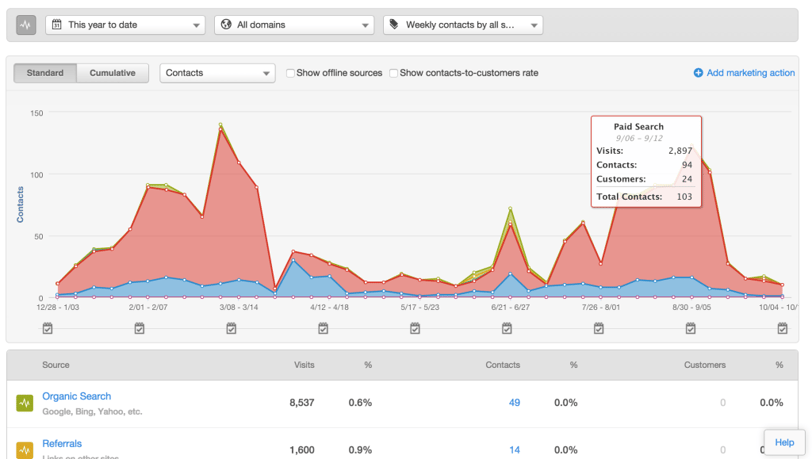Before you start reading, insert the A-Team theme song and imagine John “Hannibal” Smith lighting his cigar as he says, “I love it when a plan comes together.” Apologies in advance, but you may now have this song in your head for the rest of the day.
All too often, we meet with clients who are spending $30,000, $50,000, or even a $100,000 per year or much more on their sales/marketing and advertising efforts where they not only end up unsure if they’re getting the coveted ROI they hope for, they’re also unsure what success even looks like.
A process and roadmap designed to consider what it will take to achieve ROI and success is 1 of 2 critical steps frequently overlooked in today's world of instant gratification and “rushing to deliverables.” Stuck in this breathless loop, it's all too common for marketing agencies and in-house sales and marketing teams alike to never quite gain the clarity and vision they need to know if they’re a success or failure.
To measure that crucial difference, we take these two steps:
Step 1: We talk about a simple acronym called GPCT to form a game plan, introduce some advanced software tools that give our clients and campaigns the vision needed to point themselves in the right direction, and finally provide a dashboard that tells everyone if they’re staying the course.
Step 2: Throughout the discussion about GPCT, we’ll talk about some of the success metrics that need to be defined and tracked throughout the campaign as well as some ways you can hold up a measuring stick every so often to add vision and clarity to your spending. Get ready for restful nights of sleep ahead once the hard work is done, because very soon you’ll know where you’re bleeding and where you’re winning once all is in place.
GPCT
GPCT stands for Goals, Plans, Challenges, and Timeline. This process gives you the framework to flesh out your campaign, include all the necessary details, and test and tweak it to reach your goals. Let's walk through it and talk about a tiny handful of the technical chops required to put not only eyeballs on your new sales and marketing machine, but also hook up a “central nervous system” that will allow you to see and feel what’s working and what’s not.
Setting Goals
The rule of thumb for goal setting is that they should be SMART goals:
- Specific
- Measurable
- Achievable
- Results Driven
- Time-Bound
SMART goals give you something to strive for that can be tracked and measured within a specific time period. Using this method of goal setting, you know exactly how much more you need to do in order to reach a goal. The most important part of this method is that you can track and measure your progress. Further along, we’ll break our goals down into quarterly, monthly, and weekly increments and revisit them frequently.
After defining our goals, it’s paramount to have a system in place that allows oversight and accountability on how we’re capitalizing on every opportunity. We want to know how a new prospect found us, what content or marketing communications they consumed prior to inquiring, and we even want to see what steps were taken by a sales team or a marketing automation solution to nurture them through the middle of the funnel.
A sales CRM system is a crucial component that provides the measurability to identify “wins” for future analysis and facilitate reverse engineering. You don’t know what you don’t know and without an integrated marketing and sales CRM software in place, it can confound the process of identifying what tactics and parts of your strategy are producing the results and which ones are a waste of time and money.

Planning
Once your goals are set with all of these technical implementations in place for accountability and measurement, you can start planning. You know where you need to end up (your goals), therefore now you need to map out the steps that will take you there. You can break down your overall goals into smaller goals to help you plan each step along the way. If the plan does not achieve the partial goal, you can revise it to get back on track.
With interim goals, you can stop and examine your metrics to see if your plan is following the tenets set out in the goals. Since you know what successful results will look like and can estimate how long it should take to get them, measuring becomes easier. Analyzing past performance also helps us make our plans more realistic and it’s important to mention that analysis in aggregate isn’t helping anyone. If you’re spending any money on marketing and advertising, you better see traffic and visits moving up and to the right on a graph. We want to know channel specifics to help us set SMARTer goals and develop more precise yardsticks and better plans.

We prefer to work with sales and marketing software that ties all of this together, puts a bow on top, and is delivered right to the inbox of all of our stakeholders. For an example of what that would look like, you need only to glance at the above screenshot.

*Context is important to analysis. It makes a big difference if these results were from one day versus a month, quarter, or year.
Challenges
Every plan has challenges. You can create workarounds ahead of time for known challenges. Mike Tyson once said, “Everyone has a plan ‘till they get punched in the mouth.” For instance, if you know that February is your slowest month of the year, you can incorporate methods of achieving your goal in February ahead of time, effectively allowing us to have a better idea of when to “duck and jab” or if nothing else, brace ourselves for what we know is coming.
Every plan will also face a challenge or two you didn't plan for. Therefore, it’s useful to evaluate your planned workarounds for known challenges to identify and develop new workarounds we can place on standby for those “what if” scenarios.
You should also build in some leeway into your plans. Make short-term goals larger than they need to be to prepare for future obstacles. Challenges are part of every marketing process. If you expect to have them, you won't be thrown when your plans do not work. One way to look at it is to say to yourself that challenges are part of reaching your goals. If you can overcome the challenge, you know you will definitely reach the goal.
Timeline
Finally, all marketing plans need a timeline. The timeline gives you a "box" to work within. You know exactly when you need to complete your goals. Once you know when the timeline ends, you can work backwards to break down your goals into shorter-term goals. If your marketing plan is for one year and you have set a one-year goal, then you can break it down into monthly, weekly, and daily goals.
You can then implement your activities and strategies that will push you to reach the shorter goals. As you track your progress, you can adjust the short-term goals to keep your marketing plan moving in the right direction. In a way, this process sounds simplistic. When you start working with it, the simple ideas help make complex strategies much simpler to understand, measure, and execute.
Conclusion
The planning and technical considerations to roadmap a blueprint for success and put a system in place for tracking and analysis along the way are sometimes thought to be the “hard part.” However, the upfront work of implementation will pay for itself many times over when it gives you the vision you need to see and feel your way down the path towards achieving your goals. Put simply, a process and roadmap helps you better celebrate victories and learn from defeats. These critical but often overlooked steps can help your existing marketing and advertising dollars get more mileage.




